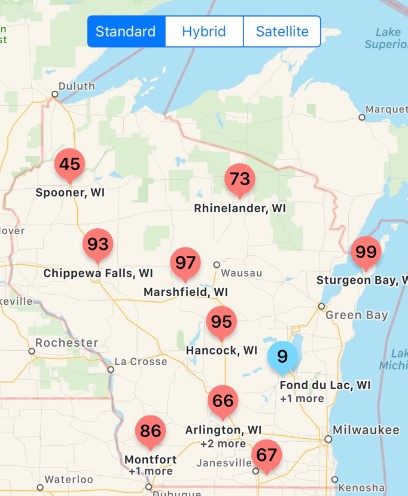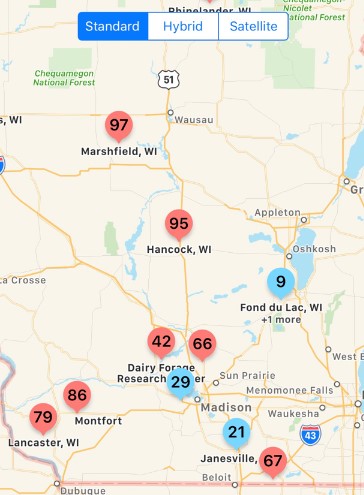By Damon Smith
Figure 1 shows the calculated risk from Tarspotter for July 11, 2019, for various locations in Wisconsin. Figure 2 shows the risk for locations in southern and south-central Wisconsin. As you can see, the present risk remains generally high for tar spot development in all locations examined. However, risk percentages have dropped over the last week, for the most part. The continued elevated risk is due to the fact that the humidity was high over the last weekend, despite warmer temperatures. As temperatures climb and conditions remain dry, expect risk to decline. Tar spot is favored by persistent temperatures between 60 and 70 F and high relative humidity averaging above 75% for a 30-day period.

Figure 1. Tarspotter risk predictions for the state of Wisconsin on July 11, 2019.
Frass Happens!
That’s right folks, frass or bug poop is a common reality in corn fields. With all of the hype concerning tar spot, it has gotten folks out scouting corn. This is a good thing. However, we have received many samples in our diagnostic clinic that were submitted for tar spot confirmation. So far, these have all been confirmed to be insect frass or bug poop (Fig. 3). We have also scouted fields in Dane co., Walworth Co., Grant Co., and Lafayette Co. and have not observed tar spot in any fields visited. We have seen lots of insect frass though.
How can you tell if it is bug poop and not tar spot? Use a little spit or some water from a water bottle. Wet the leaf and lightly rub. Bug poop will come off, tar spot will not. In addition, tar spot spots will be raised and can be felt when you rub your finger across the black spot. Frass generally won’t feel like it is raised. Continue to scout and send samples. It is always better to get a confirmation, before you spray. If it is nothing to worry about, you can save the trip and the money!

Figure 2. Tarspotter risk predictions for southern Wisconsin on July 11, 2019.
The Current Recommendation
While weather continues to be mostly conducive for tar spot, evaluate the likelihood that tar spot might develop in your field. Remember, if you have no history of the disease, then the likelihood of local inoculum being present is low. Saving the fungicide application for as as close to tassel or white silking periods will be the best option resulting in the highest return on the fungicide investment. If you have a history and you know you have a susceptible hybrid coupled with a no-till situation, then the risk is higher and you need to evaluate the economics of doing an application of fungicide as early as V6. Remember, if you do a V6-V8 application of fungicide, conditions could stay conducive later in the season for tar spot. Those early applications will “burn out” by the time the tasseling period rolls around. So if you do put a fungicide spray on at V6, you might have to come back at VT with another application to protect plants during the reproductive phase, should we stay in favorable conditions for tar spot. Keep an eye on the weather and keep scouting!
Source: wisc.edu